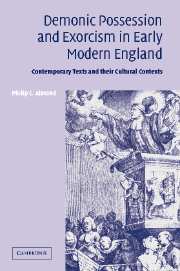 Demonic Possession and Exorcism in Early Modern England
Demonic Possession and Exorcism in Early Modern England Published online by Cambridge University Press: 22 September 2009
In 1762, William Hogarth's print ‘Credulity, Superstition, and Fanaticism’ was published. Along with the Cock Lane Ghost, the Drummer of Tedworth, the Ghost of Julius Caesar and Mary Toft the woman who gave birth to live rabbits, there is pictured a small boy huddled beneath the pulpit, vomiting hob nails and iron staples. The youth pictured is the twelve or thirteen-year-old William Perry, otherwise known as the boy of Bilson, who confessed on 8 October 1620 to having counterfeited his possession.
The Boy of Bilson is a collection of texts brought together by Richard Baddeley, secretary to the inquiry which led to the apparent exposure of William Perry. It consists of seven different texts. The first of these is a discourse on the Catholic exorcising of unclean spirits in twenty-three advertisements or admonitions, the last of which is the account of the exorcism of William Perry by Master Wheeler, one of the priests involved. There then follows an account of the trial of the witch accused of bewitching Perry, and of Perry's exposure as a fraud probably written by Baddeley. Two examinations and confessions of Perry before Thomas Morton, Bishop of Lichfield and Coventry, are followed by Perry's acknowledgement of his counterfeit. The edition concludes with the Catholic gentleman Thomas Nechils' declaration that Wheeler's written account of the case was a genuine one, personally given to him by the priest.
To save this book to your Kindle, first ensure no-reply@cambridge.org is added to your Approved Personal Document E-mail List under your Personal Document Settings on the Manage Your Content and Devices page of your Amazon account. Then enter the ‘name’ part of your Kindle email address below. Find out more about saving to your Kindle.
Note you can select to save to either the @free.kindle.com or @kindle.com variations. ‘@free.kindle.com’ emails are free but can only be saved to your device when it is connected to wi-fi. ‘@kindle.com’ emails can be delivered even when you are not connected to wi-fi, but note that service fees apply.
Find out more about the Kindle Personal Document Service.
To save content items to your account, please confirm that you agree to abide by our usage policies. If this is the first time you use this feature, you will be asked to authorise Cambridge Core to connect with your account. Find out more about saving content to Dropbox.
To save content items to your account, please confirm that you agree to abide by our usage policies. If this is the first time you use this feature, you will be asked to authorise Cambridge Core to connect with your account. Find out more about saving content to Google Drive.